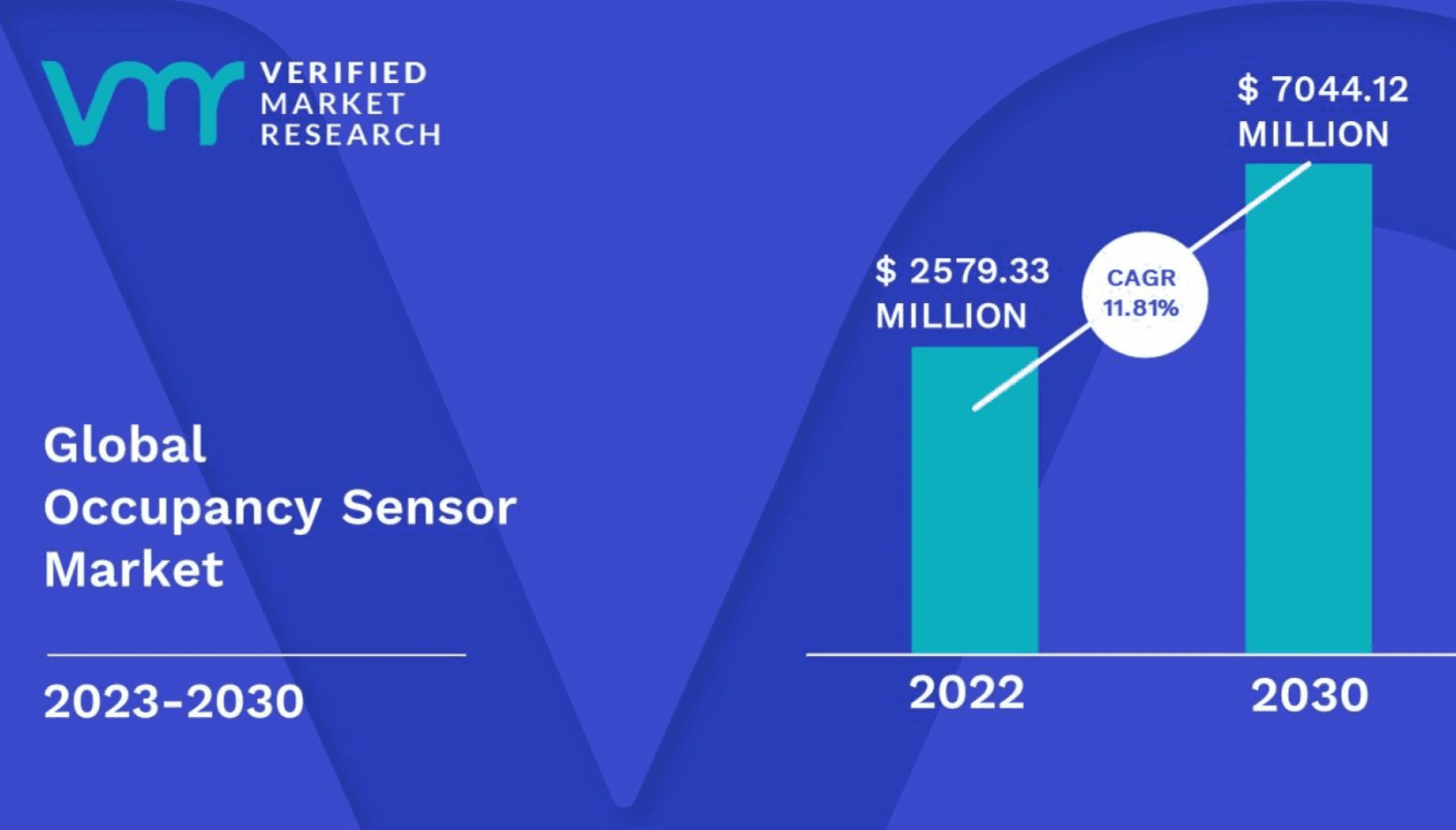- Features
- Solutions
- Pricing
- Resources
- Contact
- Book a demo

Table of Contents
- 1. Reduce Your Costs
- 2. Improve Coworking Experience
- 3. Meet Safety, Compliance, and Hygiene Regulations
- 4. Employ Data-Driven Decisions
- 5. Automate Heating and Lighting
- 6. Increase Productivity
- 7. Utilize Desk and Room Reservations
- 8. Monitor Air Quality and Overcrowding
- Help to Create a People-Centric Coworking Space
The Internet of Things (IoT) is no longer science fiction. It’s here and already in use, whether you’re aware of it or not. It’s not that robots have taken over per se, at least not just yet, but they have well and truly arrived on the scene. In essence, the IoT is about the interconnectivity of physical objects and the Internet. Think smartphones, homes, and watches.
But its reach can go far beyond those things, and today, smart buildings are now in operation, with occupancy sensors doing much of the heavy lifting. These no-touch solutions can not only save you time and money but also protect members’ well-being and monitor air quality and overcrowding.
The fourth industrial revolution is here, and the occupancy sensor market size is growing rapidly. If you’re already tapping into what they can do for your coworking space, or even if you are completely new to the concept, we’ll build on your knowledge and dive into the greater benefits of how using them can help you.

Image sourced from Verified Market Research
1. Reduce Your Costs
By using occupancy sensors in your coworking space, you will be dramatically reducing your costs. Knowing that a particular meeting room or area won’t be heated or have its lights on if it’s not being used will save you money and help you work within your budget more easily.
One of the biggest wastes of money (not to mention energy consumption) is when lights and heating are left on overnight or all weekend simply because someone forgot to switch them off. With occupancy sensors, these utilities will be triggered automatically depending on who is using the space.
This will help you streamline your costs and know that you are being energy efficient and green in the process. You will be in control if anything needs tweaking, depending on the season or feedback from the people working there. All this leaves you with more time for the important stuff, like managing your coworking space.
2. Improve Coworking Experience
People will appreciate working in a building or space that utilizes occupancy sensors. It will improve their overall experience and mean that they will likely keep returning to use the facilities.
It may sound insignificant, but to walk into a conference or meeting room and have the lights and heating adjust automatically can delight people—it’s a couple of things they don’t have to worry about whilst preparing before others to come in. It frees up their mental space and energy to concentrate on important things.
And these days, your average person is way more concerned about their health and the environment, so they will greatly appreciate knowing that they are working in an energy-saving space and that it is cleaned systematically, depending on use. Working in a place that wastes energy and has archaic utility systems in place will have a lot of people going elsewhere.
3. Meet Safety, Compliance, and Hygiene Regulations

Living in the aftermath of a global pandemic means that you need to be super-conscious of safety, compliance, and hygiene regulations. But with the help of occupancy sensors, this no longer has to be the laborious and manual task that it once was. We’ve moved on from when you would need to pin a sheet of paper to the wall for cleaners to mark up throughout the day.
For example, by monitoring how often a particular space is frequented (let’s say, a toilet or kitchen area), you will know when to schedule cleaning. This will save you money, keep the people working there safe and leave you more time for other things, like comparing Aircall competitors.
Similarly, by knowing how densely populated an area is, you can adjust the influx of people accordingly. Some places of work still employ a certain level of social distancing, so this kind of data can be very useful.
4. Employ Data-Driven Decisions
Gone are the days when you would have to guess and make trial-and-error decisions around the use of your facilities. With occupancy sensors, you will have cold, complex data to rely on.
For example, if a particular desk or meeting room isn’t being used, you can adjust accordingly and perhaps save some money. Likewise, if people favor a kitchen or toilet, you can ensure it is cleaned enough to keep up with its use.
Data-driven decisions mean that you won’t be wasting your time or money. You won’t have to surmise how your coworking space is being utilized—you’ll know. And nothing is set in stone, so if circumstances change, you can quickly re-calibrate.
5. Automate Heating and Lighting
As previously mentioned, unnecessary heating and lighting can be a huge waste of money and energy. And in coworking spaces, this is particularly true, with people leaving lights and heating on overnight or even all weekend when there’s nobody there.
But with occupancy sensors, you will be safe in the knowledge that these utilities will only come on when people are detected. This saves them the hassle of making sure things are switched on or off and saves you time, money, and energy in the process.
And it goes without saying, this is much better for the environment, as coworking spaces can be large and use up a lot of energy as is. It means that if you have emission or energy targets, you’ll know you’re not using more than you need.
6. Increase Productivity
The sheer convenience of occupancy sensors will increase productivity. This will be great for people working there as well as for management.
Booking rooms and desks in advance and knowing if they are being occupied or not saves both you and your members time, leaving more of it for work. The fewer interruptions and decisions one has to make in a day, the more productive one can be.
The same goes for cleaning or locating another colleague nearby. If the technology can sense these things already, then it means productivity will increase, and more time can be spent on things like appointment scheduling.
7. Utilize Desk and Room Reservations
By knowing how and when particular spaces are being used, you can integrate a room and desk booking system. This is a great way to optimize your space and know that nothing is being wasted.
Generate recurring revenue and offer exceptional customer experience at your shared or coworking space
Workers will also appreciate being able to book a room or desk ahead of time. It helps people who work in fluid places to know that these things are guaranteed and that they can spend more time setting up cloud phone systems for those who can’t be there in person.
And if something is booked but isn’t in use, sensors can detect this, enabling it to still be used. This real-time data is what makes this kind of technology so valuable today.
8. Monitor Air Quality and Overcrowding
Now that so many of us are based in big cities, it’s essential to factor in how this can impact coworking spaces. Occupancy sensors can be used to test the air quality and see if an area is overcrowded, triggering warnings if this is the case.
This ties in with people’s health and well-being. Asthma and other breathing conditions are a lot more commonplace now, especially in big cities, so to be able to detect when a coworking space could be detrimental for such individuals is a huge benefit.
Similarly, with overcrowding—not only can this make things less comfortable (especially when you consider the additional noise pollution), but it can also affect health as more germs and viruses are spread this way.
Help to Create a People-Centric Coworking Space
The IoT and occupancy sensors, in particular, are here to stay. And in many ways, this technology is only just getting started. We’ve looked at basic solutions such as lighting and desk utilization, but the sky's the limit here.
Suppose you want to monitor air quality or even keep the coffee machine filled up. In that case, occupancy sensors can help you do this, freeing up your energy and time for other things, like making your coworking space profitable. Your members will appreciate it too!
What’s great about all this is that it helps to create people-centric coworking spaces. In recent years we have been struggling to make technology work with us rather than against us, but there’s no argument here. Occupancy sensors are a win-win for you, the members, and the environment. Embrace what they have to offer and help make a better future for everyone.
The article was written by Grace Lau. Grace is the Director of Growth Content at Dialpad, an AI-powered cloud communication platform for better and easier team collaboration. She has over 10 years of experience in content writing and strategy. Currently, she is responsible for leading branded and editorial content strategies, partnering with SEO and Ops teams to build and nurture content like this call center and BPO guide by Dialpad. Grace has also written for other domains such as Upcity and WooRank. Here is her LinkedIn.
Keep Reading

Innovation Junction: a Guide to Makerspaces in Coworking Environments

Commissary Kitchens: Expand Your Coworking Offerings

The Operator's Manual for Women-Forward Coworking Spaces

